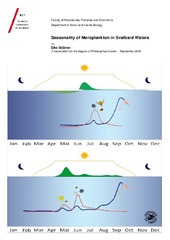| dc.contributor.advisor | Søreide, Janne | |
| dc.contributor.author | Stübner, Eike Ingrid | |
| dc.date.accessioned | 2016-12-08T13:43:08Z | |
| dc.date.available | 2016-12-08T13:43:08Z | |
| dc.date.issued | 2016-12-14 | |
| dc.description.abstract | The temporal dynamics of meroplankton, manly comprised of larvae of benthic invertebrates that only temporarily inhabit the pelagic environment, is poorly understood in Arctic environments. The main objective of this thesis was to increase our knowledge on meroplankton dynamics and their ecological role in the Arctic marine coastal ecosystem. Three different approaches including high-frequency field sampling, molecular identification (DNA bar-coding, Bivalvia) and feeding experiments (Cirripedia nauplii) were applied to investigate the highly dynamic nature of meroplankton and how they relate to biological and environmental drivers and what might be their potential feeding impact during mass occurrences. Meroplankton contributed considerably to the total zooplankton abundance during the productive time of the year. A strong correlation of total meroplankton abundance with phytoplankton biomass was observed as a general pattern. We found that the timing of the spring bloom determined the onset of the “meroplankton-boost”, which mainly comprised Cirripedia and Bivalvia larvae. Strong seasonality was also found in the occurrence of the different bivalve larval species. The feeding experiments gave limited results, since the experimental set-up needs some improvements. Our investigation suggests that benthic invertebrate larvae play a significant role in the pelagic ecosystems in Arctic coastal regions, linking the pelagic and benthic realms. The different reproductive strategies of benthic invertebrates with planktonic larvae are discussed and some speculations about potential changes in a warming Arctic climate are made. | en_US |
| dc.description.doctoraltype | ph.d. | en_US |
| dc.description.popularabstract | Meroplankton er larver av bunnlevende virvelløse dyr, evertebrater, som bare midlertidig oppholder seg i de frie vannmassene. Dynamikken i hvor og når de finnes i vannmassene gjennom året er dårlig forstått i arktiske miljøer. Hovedmålet med denne avhandlingen var å øke kunnskapen vår om meroplanktondynamikk og deres økologiske rolle i arktiske marine kystøkosystemer. Studiet ble gjennomført i tre fjordområder på Svalbard. Tre ulike tilnærminger inkludert hyppig prøvetaking i felt, molekylær identifikasjon (DNA bar-koding, hos skjell, Bivalvia) og fôringsforsøk (rur, Cirripedia nauplier) ble brukt. Vi ville vite hvordan de ulike bunndyrsgruppene bruker vannmassene til larvene sine, hvilke grupper, hvilke tidsperioder og i hvor høye konsentrasjoner og hvordan dette er styrt av de biologiske og miljømessige faktorene. Videre ville vi vite hvor mye disse gruppene bidrar til beitingen på planteplankton når de opptrer i store tettheter. Vi fant at meroplankton bidro betydelig til den totale mengden av dyreplankton i løpet av den produktive tiden av året. En sterk korrelasjon mellom total antall meroplankton og mengden planteplankton ble observert. Tidspunktet for våroppblomstringen var starten av «meroplankton-utbruddet», som i hovedsak besto av Cirripedia og Bivalvia larver. Sterk sesongvariasjoner ble også funnet i forekomsten av de ulike arter skjell-larvene som ble funnet. Beiteforsøkene ga begrensede resultater, men tyder på at kun rur-larvene ikke kan kontrollere algeoppblomstringen. Men siden larver av bunnlevende virvelløse dyr opptrer i ekstrem store mengder og vi vet at de dominerende formene spiser og bli spist av mange andre arter, er det høyst sannsynlig at de likevel spiller en betydelig rolle i de pelagiske økosystemene i arktiske kystområder og knytter sammen det pelagiske og det bentiske systemet. | en_US |
| dc.description.sponsorship | This project was funded by UNIS research funds and the Norwegian Research Council (www.forskningsradet.no) through MeroSeason I&II (Arctic Field Grant 219707/E10 & 227595), Cleopatra II (Grant Number 216537) and the ConocoPhillips and Lundin Northern Area Program as part of the Micro-Fun project. Sample analysis was partly supported by the Polish National Scientific Centre (Project Number 2736/UniPlankton/2013, www.ncn.gov.pl). Mooring data were provided through SAMS, UiT and UNIS, and were financially supported by the Norwegian Research Council through CIRCA (grant number 214271/F20). | en_US |
| dc.description | The papers I and III of this thesis are not available in Munin. <br>
Paper I: Stübner, E.I., Søreide, J.E., Reigstad, M., Marquardt, M., Blachowiak-Samolyk, K.: “Year-round meroplankton dynamics in high-Arctic Svalbard”. Available in <a href=http://dx.doi.org/10.1093/plankt/fbv124> Journal of Plankton Research 2016, 38(3):522-536. </a> <br>
Paper III: Stübner, E.I., Renaud, P., Berge, J., Gabrielsen, T. M., Reigstad, M., Kwasniewski, S., Boehnke, R., Blachowiak-Samolyk, K., Søreide, J.E.: “Timing of meroplankton in different Arctic primary production regimes”. (Manuscript). | en_US |
| dc.identifier.isbn | 978-82-8266-129-4 | |
| dc.identifier.uri | https://hdl.handle.net/10037/10018 | |
| dc.language.iso | eng | en_US |
| dc.publisher | UiT The Arctic University of Norway | en_US |
| dc.publisher | UiT Norges arktiske universitet | en_US |
| dc.rights.accessRights | openAccess | en_US |
| dc.rights.holder | Copyright 2016 The Author(s) | |
| dc.rights.uri | https://creativecommons.org/licenses/by-nc-sa/3.0 | en_US |
| dc.rights | Attribution-NonCommercial-ShareAlike 3.0 Unported (CC BY-NC-SA 3.0) | en_US |
| dc.subject | VDP::Mathematics and natural science: 400::Zoology and botany: 480::Ecology: 488 | en_US |
| dc.subject | VDP::Matematikk og Naturvitenskap: 400::Zoologiske og botaniske fag: 480::Økologi: 488 | en_US |
| dc.title | Seasonality of Meroplankton in Svalbard Waters | en_US |
| dc.type | Doctoral thesis | en_US |
| dc.type | Doktorgradsavhandling | en_US |


 English
English norsk
norsk

